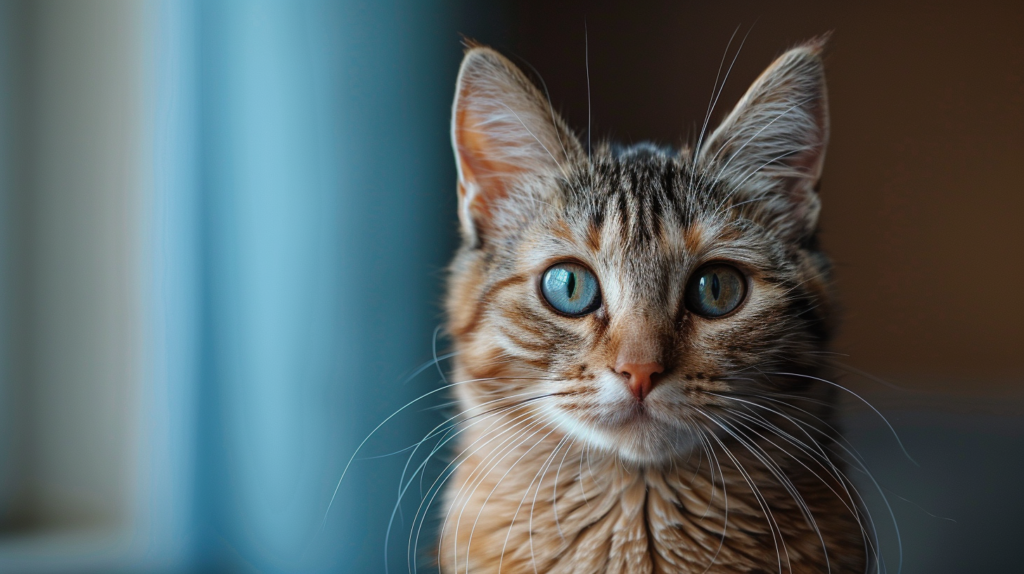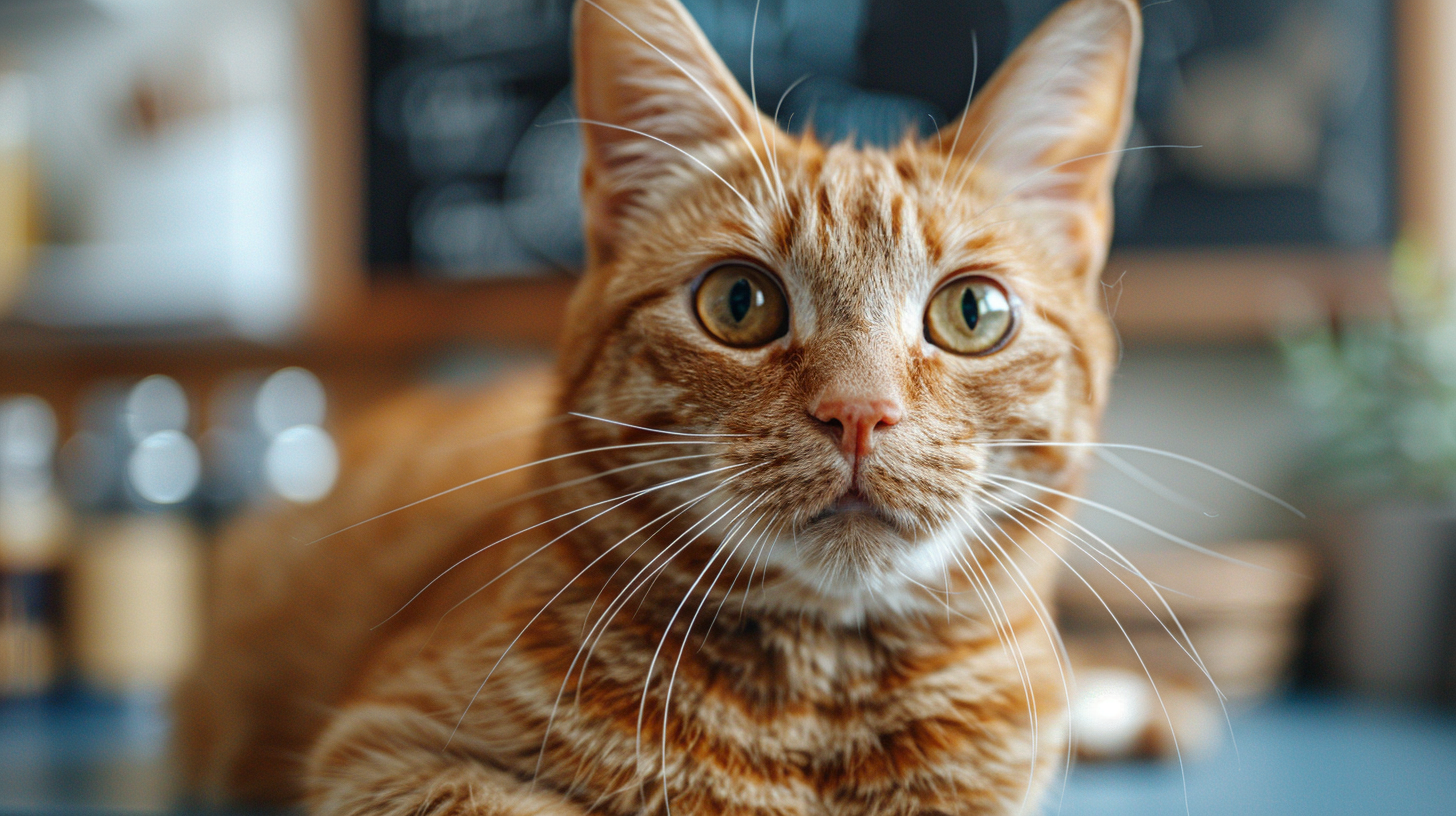Discover the truth about cats with Down syndrome. We bust 5 shocking myths and reveal what genetic conditions in cats really look like. Expert veterinary advice included.
Did you know that every month, thousands of pet owners search for information about “cats with Down syndrome” after noticing unusual facial features or behaviors in their feline companions? This widespread curiosity has led to numerous misconceptions that continue to circulate on social media and pet forums. The truth about cats with Down syndrome might surprise you – and understanding the facts could be crucial for your cat’s health and wellbeing.

While cats can indeed be born with genetic conditions that affect their appearance and development, the reality of feline genetics is far more complex than many pet owners realize. As someone who has worked with special needs cats in animal shelters across California, I’ve seen firsthand how these misconceptions can lead to unnecessary worry or, worse, improper care decisions. The distinctive facial features that some cats display often have entirely different genetic explanations than what many people assume.
In this comprehensive guide, we’ll explore the fascinating world of feline genetics, bust the most persistent myths about cats with Down syndrome, and provide you with expert-backed information to help you better understand and care for cats with special needs. Whether you’re a concerned cat owner, considering adopting a special needs feline, or simply curious about cat genetics, this article will equip you with the knowledge you need to make informed decisions about feline health and care.
Understanding Feline Genetics: The Scientific Foundation
Before diving into the myths surrounding cats with Down syndrome, it’s essential to understand the fundamental differences between human and feline genetics. Cats possess 38 chromosomes arranged in 19 pairs, while humans have 46 chromosomes in 23 pairs. This crucial difference immediately highlights why human genetic conditions cannot directly translate to our feline companions.
Down syndrome in humans specifically involves an extra copy of chromosome 21, leading to characteristic physical features, developmental delays, and various health complications. Since cats don’t possess a chromosome 21 analogous to humans, they cannot develop true Down syndrome. However, cats can experience chromosomal abnormalities that result in similar-appearing physical characteristics, which often leads to confusion among pet owners.
Feline chromosomal disorders can occur when cats have extra or missing chromosomes, similar to how Down syndrome develops in humans. These conditions might result in developmental delays, distinctive facial features, heart defects, or other health issues. The key difference lies in the specific chromosomes affected and the resulting syndrome’s characteristics.
Recent veterinary research has identified several genetic conditions in cats that can cause developmental abnormalities. These include various chromosomal trisomies, where cats have an extra chromosome in one of their 19 pairs. While these conditions can produce symptoms that superficially resemble Down syndrome characteristics, they represent entirely different genetic phenomena with unique health implications and care requirements.
Myth #1: Cats Can Have Down Syndrome Just Like Humans
The Reality: This is perhaps the most pervasive myth in feline health discussions. Cats cannot have Down syndrome because they lack the specific chromosome 21 that causes this condition in humans. What many people interpret as “feline Down syndrome” are actually other genetic conditions or developmental abnormalities that happen to produce similar physical characteristics.
Veterinary geneticists have extensively studied chromosomal abnormalities in cats and have never documented a case of true Down syndrome. Dr. Leslie Lyons, a prominent feline genetics researcher at the University of Missouri, has emphasized that while cats can have chromosomal disorders, these are species-specific and cannot be directly compared to human genetic conditions.
When cats display features that remind owners of Down syndrome – such as a flattened face, widely spaced eyes, or developmental delays – these symptoms typically result from other genetic conditions. Some possibilities include:
Cerebellar Hypoplasia: This condition affects the brain’s cerebellum, leading to coordination problems and distinctive behaviors that might be mistaken for cognitive impairment.
Congenital Heart Defects: These can cause poor growth and development, creating an appearance that some might associate with genetic syndromes.
Feline Dwarfism: Several types of dwarfism in cats can produce distinctive facial features and body proportions.
Chromosomal Trisomies: While not Down syndrome, cats can have extra chromosomes that cause developmental abnormalities.
The important takeaway is that while your cat might have a genetic condition requiring special care, it’s not Down syndrome, and accurate diagnosis is crucial for providing appropriate treatment and management.
Myth #2: Cats With Unusual Facial Features Always Have Genetic Disorders
The Reality: Many cats with distinctive facial features are perfectly healthy and simply represent natural breed variations or minor developmental differences. Not every unusual characteristic indicates a serious genetic condition requiring medical intervention.
Certain cat breeds naturally possess features that might be mistaken for signs of genetic disorders. Persian cats, for example, have been bred for extremely flat faces (brachycephalic features) that can appear similar to some characteristics associated with genetic syndromes. Similarly, breeds like the Exotic Shorthair and Himalayan cats naturally have widely spaced eyes and flattened facial profiles.
Common Normal Variations Include:
- Slight asymmetry in facial features
- Variations in ear size or positioning
- Natural differences in eye spacing
- Breed-specific facial structures
- Minor coat pattern irregularities
However, it’s important to distinguish between breed characteristics and potential health concerns. Signs that might warrant veterinary evaluation include:
- Severe breathing difficulties
- Inability to eat or drink normally
- Extreme lethargy or developmental delays
- Heart murmurs or irregular heartbeat
- Vision or hearing impairments
- Coordination problems that worsen over time
A qualified veterinarian can help determine whether your cat’s features represent normal variation, breed characteristics, or indicators of underlying health conditions requiring attention.
Table 1 – Normal Breed Variations vs. Potential Health Concerns
Markdown Version:
| Feature | Normal Breed Variation | Potential Health Concern |
|---|---|---|
| Facial Structure | Flat face in brachycephalic breeds | Severe breathing obstruction |
| Eye Spacing | Wide-set eyes in certain breeds | Eyes that don’t track together |
| Ear Position | Natural variation in ear placement | Ears that seem painful or infected |
| Body Proportions | Breed-specific size differences | Severe growth abnormalities |
| Coat Patterns | Natural color variations | Patches of missing fur or skin issues |
| Activity Level | Breed-specific energy levels | Extreme lethargy or hyperactivity |
Myth #3: Special Needs Cats Cannot Live Normal, Happy Lives
The Reality: Cats with genetic conditions or developmental differences can live fulfilling, joyful lives with appropriate care and accommodation. Many special needs cats develop strong bonds with their families and adapt remarkably well to their limitations.
The belief that cats with genetic conditions are doomed to suffer or cannot experience happiness is not only incorrect but harmful. This misconception leads to unnecessary euthanasia of adoptable cats and prevents loving families from experiencing the unique joy of caring for a special needs pet.
Success Stories from Special Needs Cats:
Cats with cerebellar hypoplasia, often called “wobbly cat syndrome,” frequently live normal lifespans with excellent quality of life. These cats learn to compensate for their coordination challenges and often become beloved family members known for their determined personalities and affectionate nature.
Blind or deaf cats similarly adapt well to their environments, relying on their other senses to navigate effectively. Many owners report that their sensory-impaired cats are particularly bonded to their human families and show remarkable intelligence in problem-solving.
Keys to Success with Special Needs Cats:
- Consistent veterinary care and monitoring
- Environmental modifications for safety and comfort
- Patient training and positive reinforcement
- Understanding of the cat’s specific limitations
- Realistic expectations about capabilities and progress
For more expert pet care tips and product recommendations, visit BlithePet.com — your trusted source for pet wellness.
The most important factor in a special needs cat’s quality of life is having a committed, informed caregiver who understands their unique needs and is prepared to provide appropriate accommodations.
Myth #4: Genetic Conditions in Cats Are Always Inherited from Parents
The Reality: While many genetic conditions are indeed inherited, others result from spontaneous genetic mutations or developmental accidents that occur during fetal development. Understanding this distinction is crucial for both breeding decisions and caring for affected cats.
Inherited genetic conditions follow predictable patterns and can often be traced through family lines. These conditions result from genes passed down from parent cats and may affect multiple offspring in a litter. Examples include certain types of dwarfism, some heart defects, and inherited metabolic disorders.
However, spontaneous genetic mutations can occur in any pregnancy, regardless of the parents’ genetic health. These random changes in DNA can happen during cell division and are not preventable through selective breeding. Chromosomal abnormalities often fall into this category, occurring when chromosomes fail to separate properly during egg or sperm formation.
Environmental factors during pregnancy can also influence fetal development:
- Exposure to toxins or medications
- Nutritional deficiencies in the mother cat
- Infections during pregnancy
- Physical trauma to the pregnant cat
- Extreme temperature fluctuations
Distinguishing Between Inherited and Spontaneous Conditions:
Genetic testing can help determine whether a condition runs in family lines or represents a new mutation. This information is valuable for:
- Making informed breeding decisions
- Understanding recurrence risks in future litters
- Providing appropriate genetic counseling for breeders
- Planning preventive care strategies
The important message for cat owners is that having a cat with a genetic condition doesn’t necessarily mean the parents were “defective” or that future offspring will be affected. Each situation is unique and requires individual evaluation.
Understanding Real Genetic Conditions in Cats
While cats cannot have Down syndrome, they can develop several legitimate genetic conditions that affect their health and development. Understanding these real conditions helps pet owners provide better care and makes informed decisions about their cats’ needs.
Cerebellar Hypoplasia is one of the most commonly misidentified conditions. This developmental disorder affects the cerebellum, the brain region responsible for coordination and balance. Cats with this condition display wobbly movements, intention tremors, and difficulty with fine motor skills. However, they typically have normal intelligence and can live happy lives with minor accommodations.
Feline Dwarfism encompasses several genetic conditions that affect bone and cartilage development. Achondroplasia, the most common form, results in shortened legs while maintaining normal body proportions elsewhere. Affected cats may have breathing difficulties if facial bones are also affected, but many live normal lifespans with appropriate care.
Chromosomal Trisomies in cats involve having an extra chromosome in one of their 19 pairs. These conditions can cause developmental delays, growth abnormalities, and various health complications. While different from human Down syndrome, these disorders can produce some superficially similar characteristics.
Congenital Heart Defects are relatively common in cats and can occur alongside other genetic conditions or as isolated problems. These may include septal defects, valve abnormalities, or structural malformations that affect the heart’s ability to pump blood effectively.
Table 2 – Real Genetic Conditions in Cats vs. Down Syndrome Myths
Markdown Version:
| Condition | Actual Symptoms | Common Misconceptions | Treatment Options |
|---|---|---|---|
| Cerebellar Hypoplasia | Wobbly movements, coordination issues | “Cat Down syndrome” | Environmental modifications, supportive care |
| Feline Dwarfism | Short legs, possible breathing issues | Genetic defect meaning poor quality of life | Regular vet checkups, weight management |
| Chromosomal Trisomy | Variable developmental delays | Same as human Down syndrome | Symptom-specific treatment |
| Congenital Heart Defects | Heart murmurs, exercise intolerance | Always fatal condition | Medication, surgical options |
| Facial Deformities | Altered facial structure | Sign of severe genetic problems | Surgical correction if necessary |
Myth #5: There’s Nothing You Can Do to Help Cats With Genetic Conditions
The Reality: Modern veterinary medicine offers numerous treatment options, management strategies, and supportive care techniques that can dramatically improve the quality of life for cats with genetic conditions. From surgical interventions to environmental modifications, many approaches can help these special cats thrive.
This defeatist myth prevents many cats from receiving the care they need and discourages potential adopters from considering special needs cats. The truth is that veterinary medicine has made tremendous advances in treating genetic conditions, and many cats with these conditions live full, comfortable lives with appropriate support.
Medical Treatment Options:
Surgical interventions can address many structural problems associated with genetic conditions. Heart defects may be correctable through cardiac surgery, breathing difficulties from facial deformities can be improved through reconstructive procedures, and orthopedic issues often respond well to surgical correction.
Medication management plays a crucial role in treating cats with genetic conditions. Heart medications can improve cardiac function, anti-inflammatory drugs can manage joint pain, and specialized diets can support cats with metabolic disorders.
Environmental Modifications:
Simple changes to your cat’s environment can make an enormous difference in their quality of life. Cats with mobility issues benefit from ramps instead of stairs, non-slip surfaces, and easily accessible food and water stations. Cats with vision problems need consistent furniture placement and tactile landmarks to navigate safely.
Supportive Care Strategies:
- Physical therapy exercises to maintain mobility and strength
- Weight management to reduce stress on joints and organs
- Regular monitoring for secondary health issues
- Mental stimulation appropriate for the cat’s abilities
- Pain management protocols when necessary
The key is working with a veterinarian experienced in special needs cats to develop a comprehensive care plan tailored to your cat’s specific condition and needs.
Warning Signs Every Cat Owner Should Know
Recognizing early signs of genetic conditions or health problems in cats can make a significant difference in treatment outcomes and quality of life. While some genetic conditions are apparent from birth, others may develop or become noticeable as cats grow and mature.
Physical Warning Signs:
Breathing difficulties that seem disproportionate to activity level may indicate heart problems or respiratory abnormalities. Cats should not struggle to breathe during normal activities or make obvious breathing sounds during rest.
Coordination problems that persist beyond typical kitten clumsiness warrant veterinary evaluation. While young cats naturally develop their coordination over time, persistent wobbling, falling, or difficulty jumping by six months of age may indicate neurological issues.
Growth abnormalities become apparent when comparing affected cats to their littermates or age-matched cats. Significant size differences, unusual body proportions, or failure to reach developmental milestones should be evaluated.
Behavioral Warning Signs:
Changes in eating or drinking habits can indicate various health problems. Difficulty eating, excessive drooling during meals, or inability to pick up food properly may suggest oral or neurological issues.
Unusual social behaviors, such as extreme withdrawal or aggression that seems out of character, might indicate pain or neurological problems affecting the cat’s perception of their environment.
When to Seek Immediate Veterinary Care:
- Difficulty breathing or blue-tinged gums
- Inability to eat or drink normally
- Loss of consciousness or seizures
- Sudden onset of coordination problems
- Signs of severe pain or distress
Early intervention often provides the best outcomes for cats with genetic conditions, making prompt veterinary evaluation crucial when concerning signs appear.
10 Expert Tips for Caring for Special Needs Cats
Based on years of veterinary experience and research into feline genetic conditions, these expert tips can help you provide the best possible care for cats with special needs:
1. Establish a Relationship with a Veterinarian Experienced in Genetic Conditions Not all veterinarians have extensive experience with rare genetic conditions in cats. Seek out a practice that has experience with special needs animals or can refer you to appropriate specialists when needed.
2. Create a Safe, Accessible Environment Modify your home to accommodate your cat’s specific limitations. This might include providing ramps, securing potentially dangerous areas, or ensuring easy access to essential resources like food, water, and litter boxes.
3. Maintain Consistent Routines Cats with genetic conditions often benefit from predictable daily routines. Consistent feeding times, regular veterinary checkups, and stable environmental conditions help reduce stress and support overall health.
4. Monitor Weight Carefully Many cats with genetic conditions are prone to weight gain due to reduced activity levels. Excess weight can exacerbate breathing problems, joint issues, and heart conditions. Work with your veterinarian to establish an appropriate diet and feeding schedule.
5. Provide Mental Stimulation Appropriate for Your Cat’s Abilities Even cats with physical limitations can benefit from mental enrichment. Puzzle feeders, interactive toys, and training exercises can provide stimulation without overtaxing physical capabilities.
6. Learn to Recognize Your Cat’s Normal Baseline Understanding what’s normal for your specific cat helps you identify changes that might indicate health problems. Keep records of eating habits, activity levels, and any symptoms you observe.
7. Connect with Support Networks Online communities and local support groups for special needs pet owners can provide valuable advice, emotional support, and practical tips from others who understand your challenges.
8. Budget for Ongoing Medical Care Cats with genetic conditions typically require more frequent veterinary care than healthy cats. Plan financially for regular checkups, potential emergency care, and ongoing treatments.
9. Focus on Quality of Life, Not Perfection Your cat doesn’t need to be “normal” to be happy. Focus on ensuring comfort, reducing pain, and providing opportunities for your cat to engage in enjoyable activities within their capabilities.
10. Educate Others About Your Cat’s Condition Help dispel myths and misconceptions by sharing accurate information about your cat’s condition with friends, family, and other pet owners. Your experience can help other cats receive better understanding and care.
Table 3 – Emergency vs. Routine Care for Special Needs Cats
Markdown Version:
| Situation | Emergency Care Needed | Routine Care Sufficient | Action Steps |
|---|---|---|---|
| Breathing Changes | Labored breathing, blue gums | Slight increase in breathing rate | Emergency vet vs. monitor and call vet |
| Mobility Issues | Sudden loss of mobility | Gradual decline in movement | Immediate evaluation vs. scheduled appointment |
| Eating Problems | Complete refusal to eat 24+ hours | Reduced appetite for 2-3 days | Emergency care vs. dietary adjustment |
| Behavioral Changes | Extreme lethargy, unresponsiveness | Mild decrease in activity | Urgent evaluation vs. observation |
| Pain Signs | Vocalization, hiding, aggression | Occasional discomfort signs | Pain medication vs. comfort measures |
| Coordination | New onset wobbling or falling | Stable coordination issues | Neurological exam vs. environmental modification |
Common Mistakes Cat Owners Make
Understanding and avoiding these common mistakes can significantly improve outcomes for cats with genetic conditions or special needs:
Mistake #1: Assuming the Worst Many cat owners immediately assume that unusual physical characteristics or behaviors indicate serious, untreatable conditions. This leads to premature decisions about euthanasia or giving up on cats who could live happy lives with appropriate care.
Mistake #2: Self-Diagnosing Based on Internet Research While online resources can be helpful, they cannot replace professional veterinary evaluation. Many conditions have similar symptoms, and accurate diagnosis requires specialized training and diagnostic tools.
Mistake #3: Delaying Veterinary Care Some owners hope that problems will resolve on their own or fear the cost of veterinary care. Early intervention often provides better outcomes and may actually be less expensive than treating advanced conditions.
Mistake #4: Over-Restricting the Cat’s Activities While safety is important, unnecessarily limiting a cat’s activities can lead to muscle weakness, depression, and reduced quality of life. Most cats with genetic conditions can safely engage in modified versions of normal cat behaviors.
Mistake #5: Focusing Only on Limitations Rather Than Abilities Cats with special needs often adapt remarkably well to their limitations and find ways to enjoy life. Concentrating on what your cat can do, rather than what they cannot do, benefits both you and your pet.
Mistake #6: Inconsistent Medication or Treatment Protocols Skipping doses, changing medications without veterinary guidance, or inconsistent treatment can worsen symptoms and delay progress.
Have you ever wondered how your own assumptions about pet health might be affecting your cat’s care? Consider how these common mistakes might apply to your situation and discuss any concerns with your veterinarian.
When to Consult a Veterinarian
Knowing when to seek professional veterinary care is crucial for cats with genetic conditions or suspected health problems. While some situations require immediate emergency attention, others can be addressed during regular appointments with proper scheduling.
Immediate Emergency Situations:
Breathing distress represents a true emergency requiring immediate veterinary attention. Cats showing labored breathing, open-mouth breathing, or blue-tinged gums need emergency care regardless of their baseline health status.
Neurological symptoms such as seizures, loss of consciousness, or sudden onset of severe coordination problems require immediate evaluation. These symptoms can indicate serious complications that may be treatable if addressed quickly.
Inability to eat or drink for more than 24 hours, especially in cats with existing health conditions, warrants urgent care. Cats can develop serious complications from extended periods without nutrition.
Situations Requiring Prompt but Non-Emergency Care:
Gradual changes in mobility, appetite, or behavior should be evaluated within a few days. While not immediately life-threatening, these changes may indicate progression of existing conditions or development of new problems.
New symptoms in cats with known genetic conditions should be evaluated promptly to determine if they represent expected progression or new complications requiring treatment modifications.
Routine Monitoring Situations:
Cats with genetic conditions typically require more frequent routine checkups than healthy cats. Your veterinarian can help establish an appropriate monitoring schedule based on your cat’s specific condition and needs.
Annual or semi-annual wellness exams should include thorough evaluation of all body systems, with particular attention to areas affected by your cat’s genetic condition.
Regular communication with your veterinary team helps ensure that changes are noticed early and addressed appropriately. Don’t hesitate to call with questions or concerns – experienced veterinarians prefer to address problems early rather than deal with emergencies.
Step-by-Step Guide to Supporting Your Special Needs Cat
This comprehensive guide will help you provide optimal care for cats with genetic conditions or special needs:
Step 1: Establish Accurate Diagnosis Work with your veterinarian to obtain a definitive diagnosis of your cat’s condition. This may require specialized testing, consultation with veterinary specialists, or referral to veterinary teaching hospitals with advanced diagnostic capabilities.
Step 2: Develop a Comprehensive Care Plan Create a detailed care plan that addresses your cat’s specific needs, including medical management, environmental modifications, and monitoring protocols. This plan should be developed in collaboration with your veterinary team.
Step 3: Modify Your Home Environment Make necessary changes to your living space to accommodate your cat’s limitations while maintaining their safety and independence. This might include installing ramps, securing dangerous areas, or reorganizing furniture.
Step 4: Establish Routines and Monitoring Protocols Develop consistent daily routines for feeding, medication administration, and activity. Create monitoring systems to track your cat’s condition and identify changes that might require veterinary attention.
Step 5: Build Your Support Network Connect with other special needs cat owners, join online communities, and maintain strong communication with your veterinary team. Having support from others who understand your challenges can be invaluable.
Step 6: Plan for Long-Term Care Consider the long-term implications of your cat’s condition, including potential progression, treatment costs, and quality of life issues. Planning ahead helps ensure that you can provide consistent care throughout your cat’s life.
Step 7: Educate Yourself and Others Continue learning about your cat’s condition and share accurate information with others. Your knowledge and experience can help dispel myths and improve understanding of special needs cats.
FAQ Section (Schema-Ready)
Frequently Asked Questions About Cats With Down Syndrome
Conclusion: The Truth About Cats With Down Syndrome
Understanding the facts about cats with Down syndrome and genetic conditions is crucial for providing proper care and making informed decisions about feline health. While cats cannot have true Down syndrome due to fundamental differences in chromosomal structure, they can develop various genetic conditions that require specialized care and attention.
The five myths we’ve explored – that cats can have Down syndrome like humans, that unusual features always indicate genetic disorders, that special needs cats cannot live normal lives, that genetic conditions are always inherited, and that nothing can be done to help affected cats – represent dangerous misconceptions that can lead to poor care decisions and unnecessary suffering.
The reality is far more hopeful. Modern veterinary medicine offers numerous treatment options for cats with genetic conditions, and many of these special cats live happy, fulfilling lives with appropriate support. Environmental modifications, medical management, and committed caregiving can dramatically improve quality of life for cats with special needs.
As we’ve seen, accurate diagnosis is the foundation of proper care. Working with experienced veterinarians, understanding your cat’s specific condition, and developing comprehensive care plans make the difference between mere survival and true thriving for cats with genetic conditions.
Whether you’re caring for a cat with special needs, considering adoption of a special needs cat, or simply seeking to understand feline genetics better, remember that knowledge and compassion are the most powerful tools for helping these remarkable animals live their best lives.
Have a similar experience with your pet? Share it in the comments below! Don’t forget to check out our other helpful guides at BlithePet.com.






